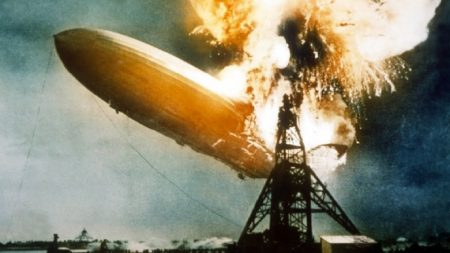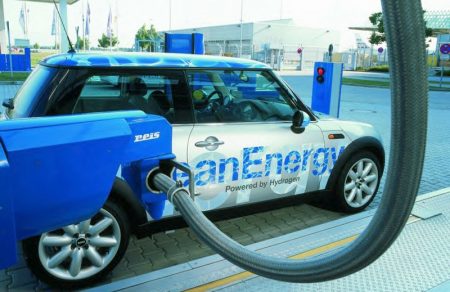May 5, 2017 – The most compelling event around hydrogen remains to this day the catastrophe of the Hindenburg, a German-built dirigible that went up in flame and smoke over Lakehurst, New Jersey on May 6, 1937. It was on the first of several planned Trans-Atlantic voyages that year between Germany and the United States.
The Hindenburg was the world’s largest airship, as big as RMS Titanic, the “unsinkable” ship that made the world aware of the potent danger of icebergs back in 1911. But like Titanic, the Hindenburg succumbed to nature. What happened at Lakehurst took a mere 40 seconds, probably ignited by a build-up of static electricity in the air after a passing thunderstorm. That combined with inflammable paint coating the sealed hydrogen storage cells within the airship’s structure ignited a spark that started the fire. Of course, if Hindenburg had used helium rather than hydrogen there never would have been that all-consuming fire that caused 36 people to die that day.
To this day when presented with hydrogen as an alternative clean fuel to replace gasoline and diesel, there is general consumer resistance. Today Toyota, Hyundai, and Honda are building hydrogen-fuelled cars. But who is buying? Not many. In an April 14, Wheel24 Motoring News article it states, “Honda, Toyota, and Hyundai have leased a few hundred fuel cell vehicles over the past three years, and expect to lease well over 1,000 in 2017.” The article continues describing General Motors supplying the U.S. Army with fuel-cell pickup trucks. But not much more is happening with hydrogen. When you compare purchases in the U.S. of electric to hydrogen-powered vehicles, the ratio is 80:1 in favour of the former over the latter in 2016.
But not much more is happening with hydrogen. And when you compare purchases of electric to hydrogen-powered vehicles in the U.S. in 2016, the ratio is 80:1 in favour of the former over the latter.
Hydrogen is clearly not catching on with consumers or the fueling network needed to deliver the gas to consumers. Here are what I believe are the most likely reasons for hydrogen’s virtual invisibility to American consumers today:
- The Hindenburg disaster has left an indelible impression on Americans about the safety of hydrogen as a fuel.
- The Hindenburg isn’t the only disaster that Americans have witnessed in their history. A liquid hydrogen leak because of the storage tank’s structural failure caused the Challenger Space Shuttle disaster in 1986, a reminder of the latent volatility of the gas.
- Hydrogen as a fuel is not burned in the conventional sense. It is used as an energy source for chemical fuel cells which produce electricity to operate vehicles. Fuel cells have been around for a long time but have yet to catch the imagination of consumers when compared to battery-powered electric vehicles. There are fuel-celled buses out there, and fuel-cell powered off-road vehicles, but very few cars and trucks.
- Harvesting most of the hydrogen we store today is a carbon intensive process because we extract it from natural gas. That means with our current hydrogen extraction processes the technology is a net carbon emitter.
- Hydrogen as a fuel has to be compressed and put into reinforced fuel tanks when used in vehicles. Compression scares people. Do you or your neighbours want to have a hydrogen-fuelled car sitting in a nearby driveway that could explode like the Hindenburg? Or do you want the local corner filling station to have a big compressed-hydrogen silo sitting a few hundred meters from your front door?
- Where are hydrogen fueling stations today? Shell recently announced it was building 10 hydrogen filling stations in California to add to the hydrogen infrastructure there. Each filling station costs about $2 million U.S. which is a pretty steep price to pay to service 1,000 cars. To date, Shell has 2 demonstration filling stations located in the city of Los Angeles and the entire country has 32 more. That makes publicly accessible hydrogen filling stations virtually non-existent across North America. It is not that case in countries like Japan and Germany where there is a growing filling station infrastructure that may increase consumer interest in hydrogen-powered cars.
- And when you get to the pump at a hydrogen filling station today, the refilling experience is not as simple as pumping gas. The picutre below shows how the current technology features non-standard, heavy couplings that require the vehicle to be mated to the hydrogen fuel source using a clunky hose with a locking mechanism at the head. That’s nothing like popping open the gas cap and filling your tank. With hydrogen filling it is anticipated that significant amounts of the gas will escape into the surrounding air adding to the human fear factor that an explosion just like the Hindenburg could occur. That, of course, will not happen because hydrogen is so light an element that the gas dissipates rapidly.


















[…] former isn’t igniting the gas to create heat. For those of us who have read the story of the Hindenberg 1937 fire, there is something both novel and reassuring about a technology that can deliver heat without […]